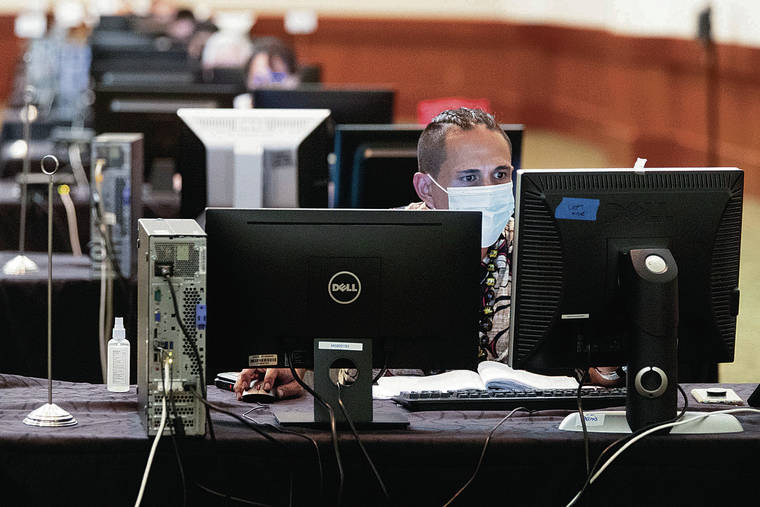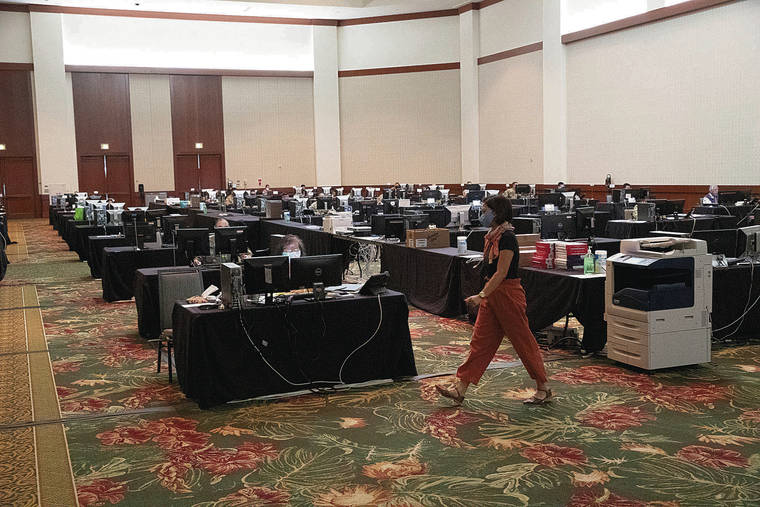Gov. David Ige defends Hawaii’s contact tracing

GEORGE F. LEE / GLEE@STARADVERTISER.COM
Hawaii National Guard personnel performed their duties as contact tracers Wednesday at the Hawai‘i Convention Center.

GEORGE F. LEE / GLEE@STARADVERTISER.COM
The Hawai‘i Convention Center has been set up so contact tracers can perform their duties, as seen above on Wednesday.


Hawaii’s COVID-19 case count rose by triple digits again Wednesday amid mounting concerns over whether the state’s contact tracing and testing program is robust enough to halt a surge in community-spread infections.
U.S. Rep. Anna Eshoo, chairwoman of the House Subcommittee on Health, sent Gov. David Ige a letter Wednesday expressing dismay about Hawaii’s rise in coronavirus cases. Eshoo questioned whether the state Department of Health has stood up an adequate contact tracing and testing program.
She also wanted an accounting of how Hawaii had spent the $50 million in federal coronavirus relief aid that was given to ensure it had adequate resources to track, trace and respond to the COVID-19 outbreak.
PHOTOS: Hawai‘i Convention Center houses new contact tracing team Opens in a new tab
“Congressional oversight is essential to ensure that states have the resources they need to adequately respond to the ongoing pandemic and that taxpayer dollars are being spent responsibly to serve the public health interest,” Eshoo wrote.
Ige defended Hawaii’s contact- tracing efforts Wednesday as “better than average and amongst the best in the country.”
Don't miss out on what's happening!
Stay in touch with breaking news, as it happens, conveniently in your email inbox. It's FREE!
Ige’s remarks came during a media briefing Wednesday at the Hawai’i Convention Center where he was joined by Department of Health director Bruce Anderson, Hawaii Emergency Management Agency director Kenneth Hara, and the DOH Disease Investigation Branch chief Emily Roberson.
Hawaii health officials reported two additional coronavirus Opens in a new tab-related fatalities on Oahu and 261 new cases in the islands Wednesday, raising the statewide total since the start of the pandemic to 5,609 infections.
The latest deaths were a Honolulu woman with underlying medical conditions and a Honolulu man. Both were over 60 years old, health officials said. No other details on the 42nd and 43rd Hawaii deaths were immediately released.
Anderson called Wednesday’s count, “reasonably good news” given that 56 of the new cases were associated with the outbreak at the Oahu Community Correctional Center (OCCC) and another 37 would have been counted in Tuesday’s numbers save for a testing backlog on the mainland.
“If you subtract those 93 cases, we still have a significant number of cases occurring, but we’re seeing fewer than we projected a week ago,” Anderson said. “The census in our hospital seems to be stable.”
Anderson said social gatherings had contributed to much of the spread. He said he was cautiously optimistic that improvements would follow a new no social gatherings for Oahu order, which went into effect on Wednesday.
He and Ige doubled down on the message that Hawaii residents need to be personally accountable for making healthy choices like wearing masks, socially distancing, practicing good hygiene and avoiding large gatherings.
“What’s going to stop this disease from spreading in Hawaii is not the number of contact tracers, it’s going to be everyone’s behavior,” Anderson said.
He also said contact tracing is only one part of a multipronged COVID-19 containment approach and that it isn’t too effective when case counts are soaring. However, he added, effective contact tracing in Hawaii did play a roll in early intervention.
Roberson, who was hired July 16 to lead the Health Department’s Disease Investigation Branch, including its contact-tracing program, said there are now 126 contact tracers on the job and another 13 support staff.
That’s only slightly up from the 105 contact tracers that DOH reported it had a few weeks ago. However, it’s significantly more than the Hawaii Government Employees Association reported in a grievance filed Aug. 6 alleging there were only 15 epidemiological specialists on Oahu and three on the neighbor islands to perform contact tracing for thousands of potential COVID-19 cases.
Roberson said the department has set up workstations at the convention center, which would allow for additional expansion of the program, but stopped short of confirming a target number.
Critics, including Lt. Gov. Josh Green, have said Hawaii should have between 420 and 564 contact tracers based on national recommendations.
Anderson said he recently contacted the Centers for Disease Control and Prevention and was told that it doesn’t have a recommendation. But he said “we hope to very soon have another 100 contact tracers to help with investigations.”
When asked about DOH’s target goal for contact tracers, Roberson said “I hesitate to put a solid number as a target because we don’t know what’ll happen tomorrow or how things might change.”
Dr. Scott Miscovich, the president and founder of Premier Medical Group Hawaii, said Hawaii needs much more contact tracing and broad testing now. He said the outbreak at OCCC is a prime example of why.
The entire facility, every guard and every inmate should have been tested in the first 24 hours, Miscovisch said. Instead, testing which began on Aug. 11, is still ongoing.
So far only 606 out of 973 inmates have been tested and Anderson and Roberson couldn’t say how long it would take to complete the process or to finish contact tracing.
“The OCCC situation is constantly evolving and there are numbers that get updated every single day so saying whether or not all the cases or the contacts have been contacted by this specific time right now is difficult to pinpoint,” Roberson said. “That being said, this is a priority group and we have focused increased resources specially on OCCC.”
The state Department of Public Safety reported Wednesday that 16 additional inmates have tested positive for COVID-19, bringing the total number of positive inmate cases from the mass testing effort to date to 215. The department also reported that two more OCCC staff had tested positive for the coronavirus, bringing the total number of positive OCCC employees to date to 41.
Miscovich said the drawn out timetable is inexcusable, especially given that DPS had been ordered to begin releasing some inmates Wednesday to comply with a pandemic-related Hawaii Supreme Court order.
“The community is at risk, the remaining inmates are at risk and guards are at risk,” Miscovich said. “Once again, the people of Hawaii have been insulted by the lack of leadership from the governor and a lack of insight by a director of DOH who clearly does not understand COVID. The lack of following best practice and worldwide best practice has led to people dying in the state of Hawaii.”
Anderson said he didn’t know the count of the inmates who were ill from COVID-19, but said there were “very few who have been hospitalized.”
“Typically, you’d expect about 1 out of 10 to be hospitalized,” he said. “I don’t think we are seeing that in this situation.”
Ige said the state continues “to test as quickly as we can given the conditions that we are facing.”
Ige said testing has to be coordinated carefully from module to module to separate those who are positive and negative for COVID-19.
Anderson said a “small riot” was among the challenges that delayed the testing.
Inmates upset with coronavirus quarantine lockdowns set a fire in the common area of a housing module Sunday and damaged a toilet and lighting fixture. On Saturday, there was another fire, and an attempted fire after a late lunch frustrated inmates.



